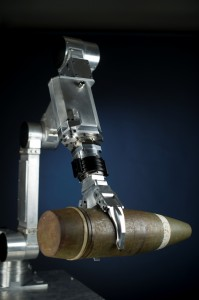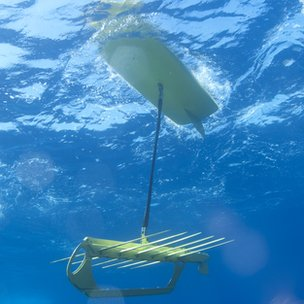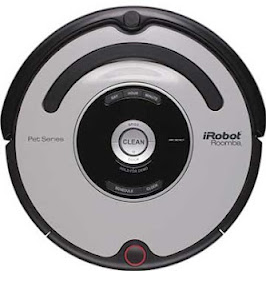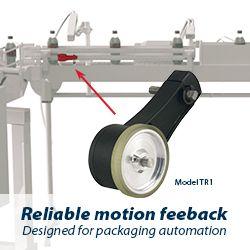Sometimes a company is founded because it stumbles upon a niche that it can fill better than any other company. Such a company is RE2 (Robotics Engineering Excellence). Founded by Jorgen Pedersen as a contract engineering house to fill a need for unmanned systems engineering expertise within Carnegie Mellons National Robotics Engineering Center (NREC), RE2 now provides mobile manipulation systems for defense and safety.
Frank Tobe and Babs Carryer | The Robot Report
RE2 began with an SBIR
A lot of robotics companies started with defense research objectives. Some, like iRobot, have branched into other applications commercializing what they developed for the DoD into consumer products. RE2 has stayed in defense because it’s really good at what it does – providing high torque, high payload robotic arms and manipulators.
Arm manipulation is a niche within defense -- a large niche -- as it is in robotics in general. Capitalizing on research and product development to meet the military's high torque, heavy payload requirements, RE2 is not only a provider to the military but is beginning to commercialize those special capabilities into non-defense applications as well.
 RE2 is a success story for the Small Business Innovative Research (SBIR) program. Founded in 2001, RE2 remained a contract engineering firm until 2005. The company won its first DoD SBIR in 2006 to develop a small robotic arm for unmanned ground vehicles. The Phase I and Phase II awards, totaling $850K, set the course for the future of RE2. The military was keenly interested in the RE2 approach because existing robotic arms weren’t very strong or precise. CEO Jorgen Pedersen puts it, “That was enough for us to focus on and realize that we could solve those problems. Then later we realized the arms needed to be faster, more modular, and less expensive. We fulfilled on those capabilities too.”
RE2 is a success story for the Small Business Innovative Research (SBIR) program. Founded in 2001, RE2 remained a contract engineering firm until 2005. The company won its first DoD SBIR in 2006 to develop a small robotic arm for unmanned ground vehicles. The Phase I and Phase II awards, totaling $850K, set the course for the future of RE2. The military was keenly interested in the RE2 approach because existing robotic arms weren’t very strong or precise. CEO Jorgen Pedersen puts it, “That was enough for us to focus on and realize that we could solve those problems. Then later we realized the arms needed to be faster, more modular, and less expensive. We fulfilled on those capabilities too.”
Those first SBIRs allowed the company to become a recognized expert in mobile manipulation. SBIRs also allowed the company to grow over a several year period from six to 18. Since then it has won dozens of SBIRs that have helped fund the development of its robotic technology and provide jobs. Today, RE2 employs 60 and is growing by about 20 every year.
RE2 never had any outside investment. It never needed it, given the string of SBIRs. But Jorgen doesn’t believe that the awards represent money without a return: “We have provided the DoD with $6.5 million in revenue return so far from their $850K investment in our first SBIRs. On the SBIR commercialization index, we are 90 out of 100 because they know that we have a 90% chance of commercializing technology over anyone else.”
Liquid Robotics: A Passion for Whale Songs
Liquid Robotics has developed a unique wave glider for science, oil and gas exploration, oil production management, environmental and spill detection and a myriad other applications using only renewable energy. It has blossomed into a very promising start-up company with a broad market: any business which needs to monitor, measure, surveil and explore our oceans. Liquid has recently created two new entities to handle its success: a joint venture with Schlumberg and a new Defense/National Security subsidiary. Liquid will soon be offering a new business: ocean data as a service for those who don't wish to own and operate their own wave gliders. Clients specify their data needs, geographic areas and duration and Liquid Robotics provides the data.
 The Wave Glider development was the result of a single man’s passion for whale songs. Joe Rizzi, Chairman of Jupiter Research Foundation, had a love for the sounds of whales as they migrated along the coasts of Hawaii to Alaska. He wanted to capture their songs “live”. Not an easy task -- to develop a device capable of capturing the pure sounds of the whales and stay out at sea for extended periods. After a few years experimenting, Joe enlisted Roger Hine, a mechanical engineer and Stanford University robotics expert, to help develop an unmoored, station-keeping data buoy. It was from this partnership they developed the first Wave Glider.
The Wave Glider development was the result of a single man’s passion for whale songs. Joe Rizzi, Chairman of Jupiter Research Foundation, had a love for the sounds of whales as they migrated along the coasts of Hawaii to Alaska. He wanted to capture their songs “live”. Not an easy task -- to develop a device capable of capturing the pure sounds of the whales and stay out at sea for extended periods. After a few years experimenting, Joe enlisted Roger Hine, a mechanical engineer and Stanford University robotics expert, to help develop an unmoored, station-keeping data buoy. It was from this partnership they developed the first Wave Glider.
The original intent was purely to invent a way to capture whale songs. After they had developed the first Wave Glider and were testing in the waters off of the Big Island, they were approached on the possible commercialization of their invention by entrepreneurs looking beyond whale songs.
Early funding was predominately done by the non-profit Jupiter Research Foundation. Roger Hine came to the project with his own funds and then headed Liquid Robotics, which, in 2007, was spun off from Jupiter Research, with angel investors and mutual friends of Joe and Roger. This money seeded the early development and critical endurance/mission testing. In May/June of 2011, Vantage Point Capital Partners and Schlumberger invested a Series D round of $22M.
A Common Thread
RE2 and Liquid Robotics share one common thread: they provided a solution involving robotics to solve a real need. They didn't provide a technology and then search for applications that fit that technology. RE2's Jorgen said, “Even on the military side, it’s still not about the robotics. We are helping to save lives. What is the price of a human life? What is the amount of money that the military will invest to train and protect their most valuable resource, people? If we can help disarm the improvised explosive device (IED) on the road, that’s a no-brainer. And that’s a market need!”
Jorgen cites the acceleration of viable robotics companies from the September 11, 2001 catastrophe: “9-11 was bad but it was a catalyst for ground robotics. In 2002 there were four robots deployed. By 2004, it had gone to12. By 2005, 163, and by 2006, 2,000 robots, an order of magnitude jump each year. 7,000 robots were deployed by 2010.” Jorgen sees that trend continuing as robots are demystified and integrated into products and services.
Similarly, Liquid Robotics had a need to develop an autonomous unmoored, station-keeping data buoy with enough renewable energy to power a platform full of sensors and devices capable of capturing the pure sounds of whales.
British Petroleum (BP) began using Liquid's wave gliders in the Gulf of Mexico shortly after the 2010 Gulf Oil Spill disaster:
"Initially we will be calibrating a set of nine optical sensors to monitor water quality, including trace amounts of dispersed oil, and will then add acoustic monitoring of marine mammal activity," said Roger Hine, president and CEO of Liquid Robotics. "We look forward to working with BP on this extended research program."
 Data collected by the deployment was posted on a public website for all to see. News spread and oil, gas and military executives saw a fit of Liquid's gliders with their oceanographic needs. Schlumberger, an international supplier of technology, integrated project management and information solutions for the oil and gas industry, took an interest which led to their 2011 funding and 2012 joint venture with Liquid.
Data collected by the deployment was posted on a public website for all to see. News spread and oil, gas and military executives saw a fit of Liquid's gliders with their oceanographic needs. Schlumberger, an international supplier of technology, integrated project management and information solutions for the oil and gas industry, took an interest which led to their 2011 funding and 2012 joint venture with Liquid.
Conclusion: Build a Product That Satisfies a Specific Need
Colin Angle, CEO and co-founder of iRobot, has consistently held that we are going about developing the robotics industry wrong: “The idea that a humanoid robot with arms would push a vacuum cleaner is an image that has set many expectations and, in some ways, has set back the industry,” when, by just rethinking what needs to be done, we can build a product that satisfies a specific need (vacuuming), as iRobot did with their Roomba line of robotic vacuums. "I used to think that I was a self-respecting high-tech entrepreneur, but it took me becoming a vacuum cleaner salesman to actually have some success for my company, my investors and myself."
** Portions of this article have been excerpted with permission from: "It takes the military to spawn robotics."
Reprinted with permission from Everything Robotic.com
The content & opinions in this article are the author’s and do not necessarily represent the views of RoboticsTomorrow
Featured Product


